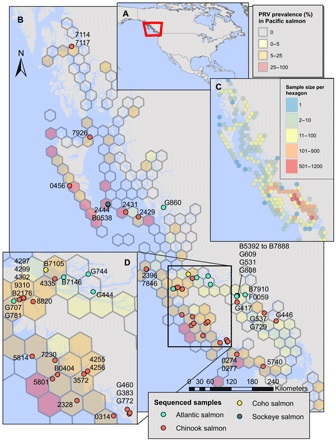The PRV virus, typical of intensive farming, is also affecting wild salmon from the Pacific Ocean. But what is its origin?
He is about to end up run over, his mother saves himThe PRV virus, typical of intensive fish farming, is also affecting wild salmon from the Pacific Ocean. But whether farmed salmon is the cause of the infection, or whether the virus already existed in British Columbia, has long been a subject of debate.
A new study shows that intensive salmon farming is also destroying wild salmon living in the Pacific Ocean with the PRV virus. Farmed salmon, like all types of farmed animals, live in very confined environments and are highly vulnerable to infectious diseases. Among salmon farmed in the Pacific Ocean, a virus, PRV, is so common that virtually every fish is affected.
There was a lot of discussion about the origin of the PRV - he explains Gordon Mordecai of the University of British Columbia. - So far it has been thought that the virus originated in British Columbia and has not given too much weight to the matter, but I do not think this is true.
To unravel the mystery, Professor Mordecai and his colleagues compared the genetic sequences of every available sample of the most common variant of the virus in the Pacific, PRV-1, from all over the world and reconstructed its evolutionary history based on the differences between the sequences and its mutations. They managed to calculate not only when the PRV-1 virus first arrived in the Pacific Northeast, but also where it came from. And they found confirmation of Professor Mordecai's suspicions - that the virus is not native to the Pacific Ocean.
(Read: The dark side of "salmon pink" that pink is not: the art installation that denounces intensive farming)
The virus would have arrived in the ocean about thirty years ago - just as aquaculture in those areas began to be more aware and sustainable, that is, in the late 80s. The variant found in the Pacific is substantially similar to that discovered in the north-east of the Atlantic Ocean: both contemporaneity and genetic similarities suggest that the virus was brought to the Pacific Ocean by salmon eggs from Norwegian farms. Since then, the virus has spread more and more, all the way to salmon farms in Chile.

Credit: Science Advanced
This work offers useful information on the origin, evolution and possible transmission dynamics of the PRV-1 virus, and also provides evidence that even wild fish can suffer from the consequences of intensive farming. It is not yet clear, however, how the introduction of the virus into wild salmon populations is affecting their survival and numbers. In intensive farming, PRV causes inflammation of the skeletal muscles and the heart - this is not necessarily a fatal condition but hinders the fish's ability to swim and forage.
Professor Mordecai argues that reducing aquaculture operations or moving intensive farming from the sea to the mainland could help reduce the pressure on wild salmon in the area. However, there are many problems facing wild salmon, and not all of them are under human control.

The distribution of the PRV-1 virus (Credit: Science Advance)
Fonte: Science Advance
We also recommend:
- Sushi mania causes salmon production to explode around the world (and the damage is incalculable)
- Bacteria-infested salmon withdrawn from the Ministry of Health
- Salmon: 10 good reasons not to eat it

























